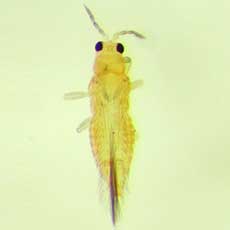Female
macropterous; body colour yellow, antennal segments III – VIII
grey; major setae pale; forewings pale. Antennae 8-segmented, III & IV
with constricted apical neck, sense cone forked and stout. Head wider
than long, postocular region and ocellar triangle with closely spaced
transverse lines of sculpture; 3 pairs of ocellar setae present, pair
III close together between anterior margins of hind ocelli; 2 pairs of
major postocular setae present. Pronotum with closely spaced transverse
lines of sculpture; posterior margin with 4 pairs of setae, B2 about
55 microns long. Mesonotum with pair of setae arising medially. Metanotum
with irregular longitudinal reticulations on posterior half, campaniform
sensilla absent, median setae close to anterior margin. Meso- and metafurca
with spinula. Forewing first vein with 3 setae on distal half, second
vein with 3 widely spaced setae; posterior fringe cilia wavy; clavus
with 3 or 4 veinal setae. Tergites III – VI with median setae small
but close together; II – VIII with lateral thirds covered in closely
spaced rows of fine microtrichia, these microtrichial fields with 4 discal
setae and posterior margin with fine comb; VIII with comb complete across
posterior margin, lateral discal microtrichia extending across middle
of tergite; IX with several rows of discal microtrichia. Sternites without
discal setae, laterally with rows of microtrichia scarcely extending
mesad of setae B1; posterior margins without comb of microtrichia; median
setae on VII arising at margin.
Male similar to female but smaller; tergite IX without a pair of stout
curved processes (drepanae); hind femora without comb-like row of stout
setae; sternites without glandular areas.
Second instar larva white, antennal segments grey; tergites covered in
irregularly arranged dot-like sculpture, pronotum without sculpture; setae
capitate on head, posterior angles of pronotum, and tergite X, remaining
setae small and acute; abdominal spiracles small. |
